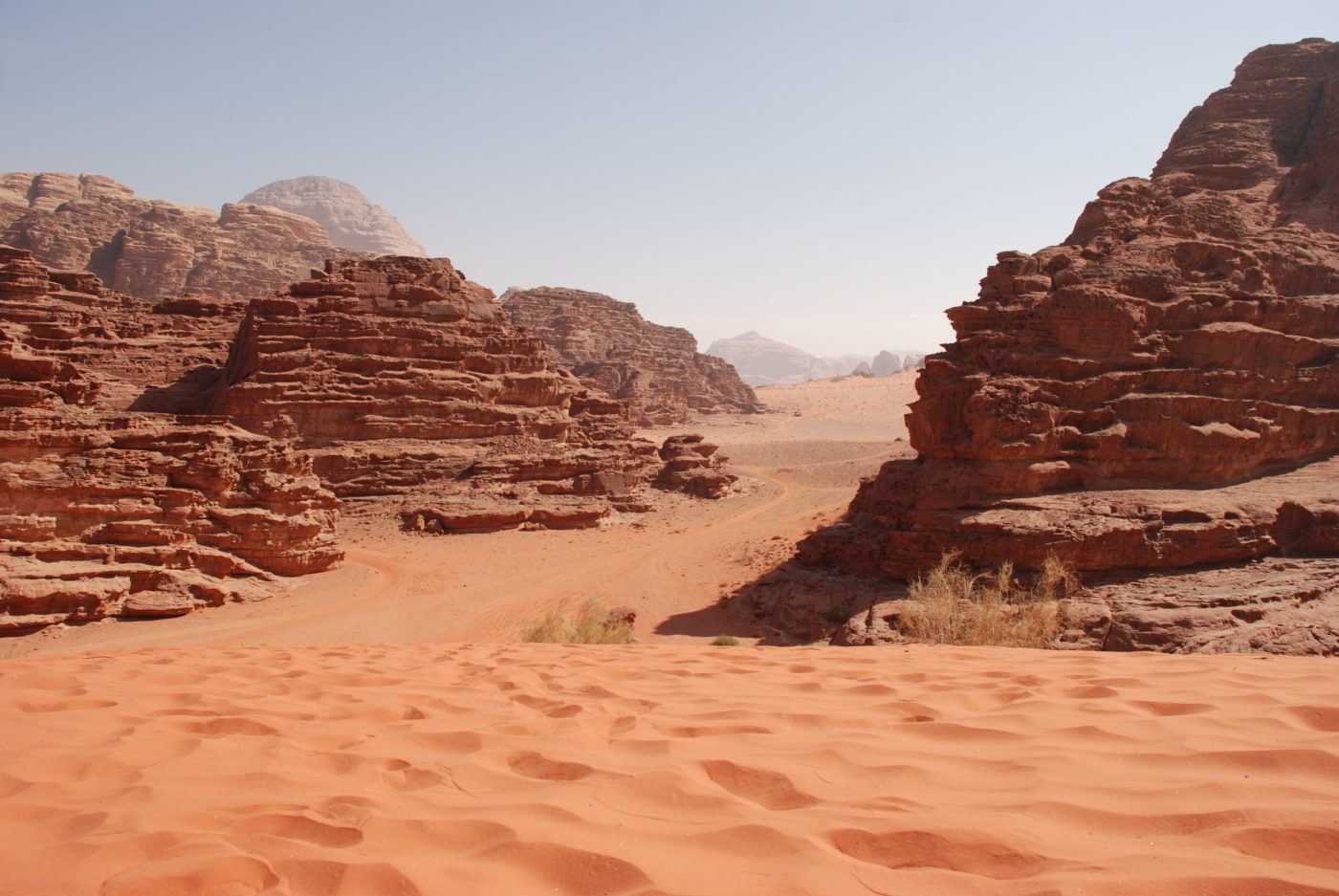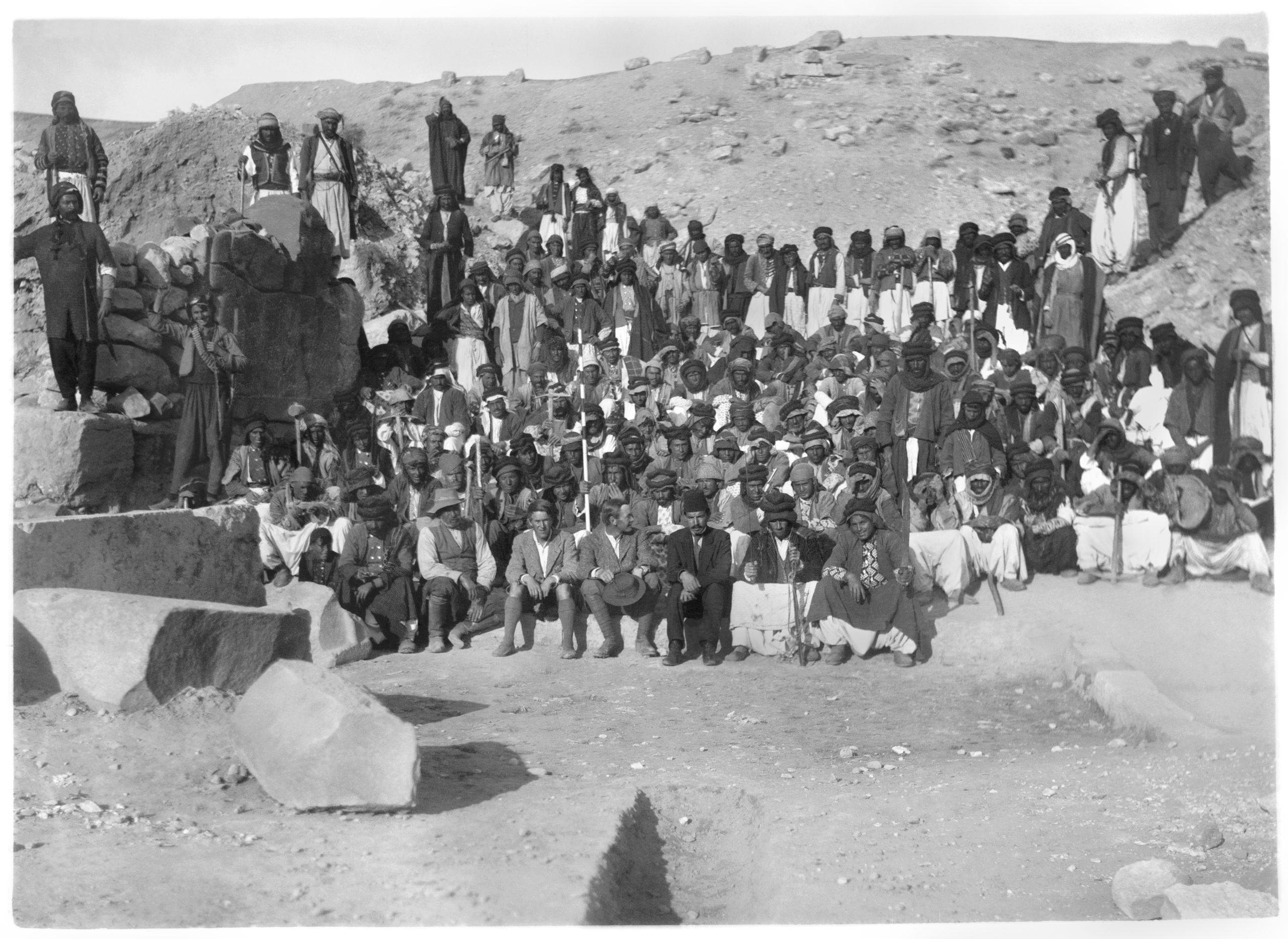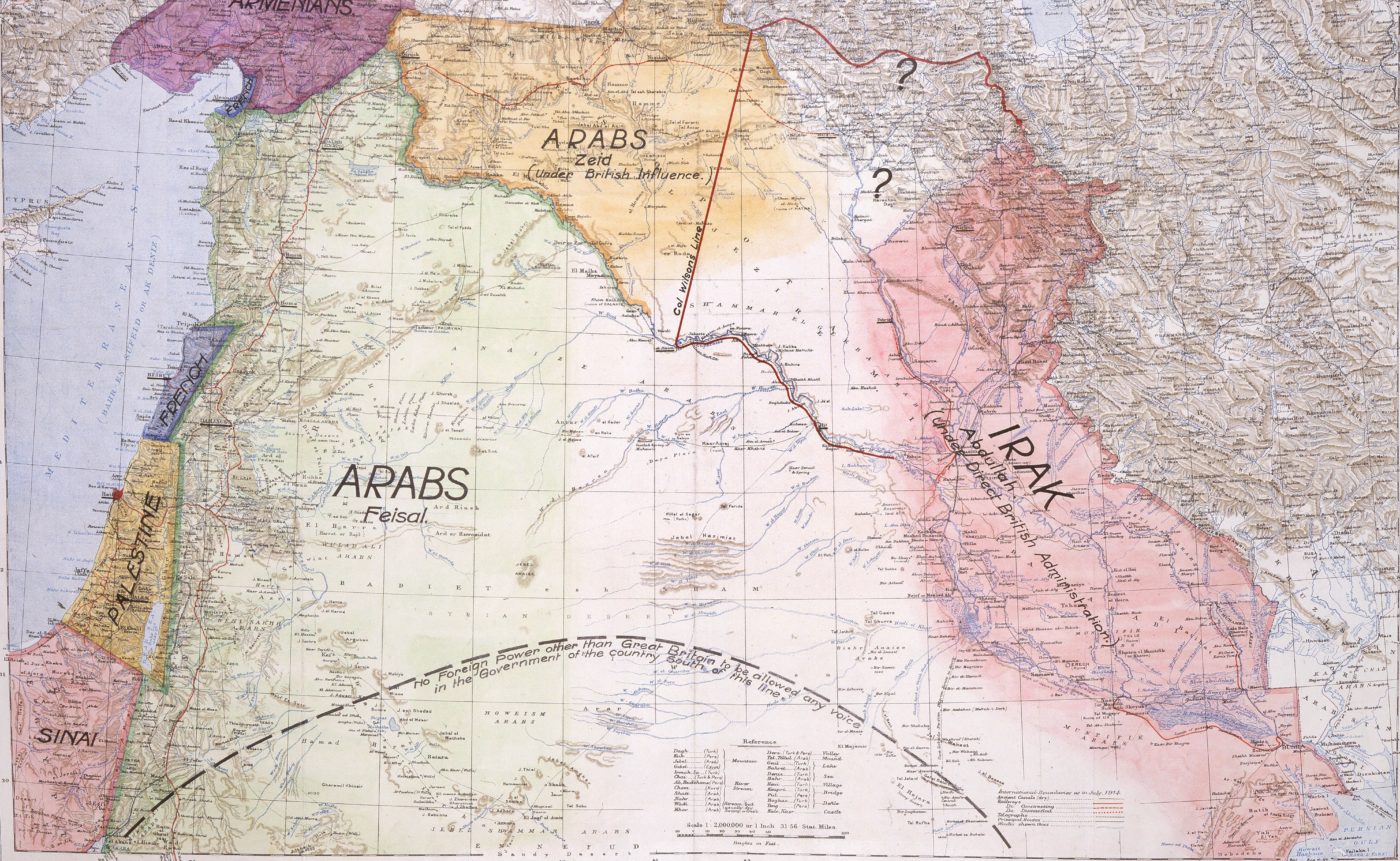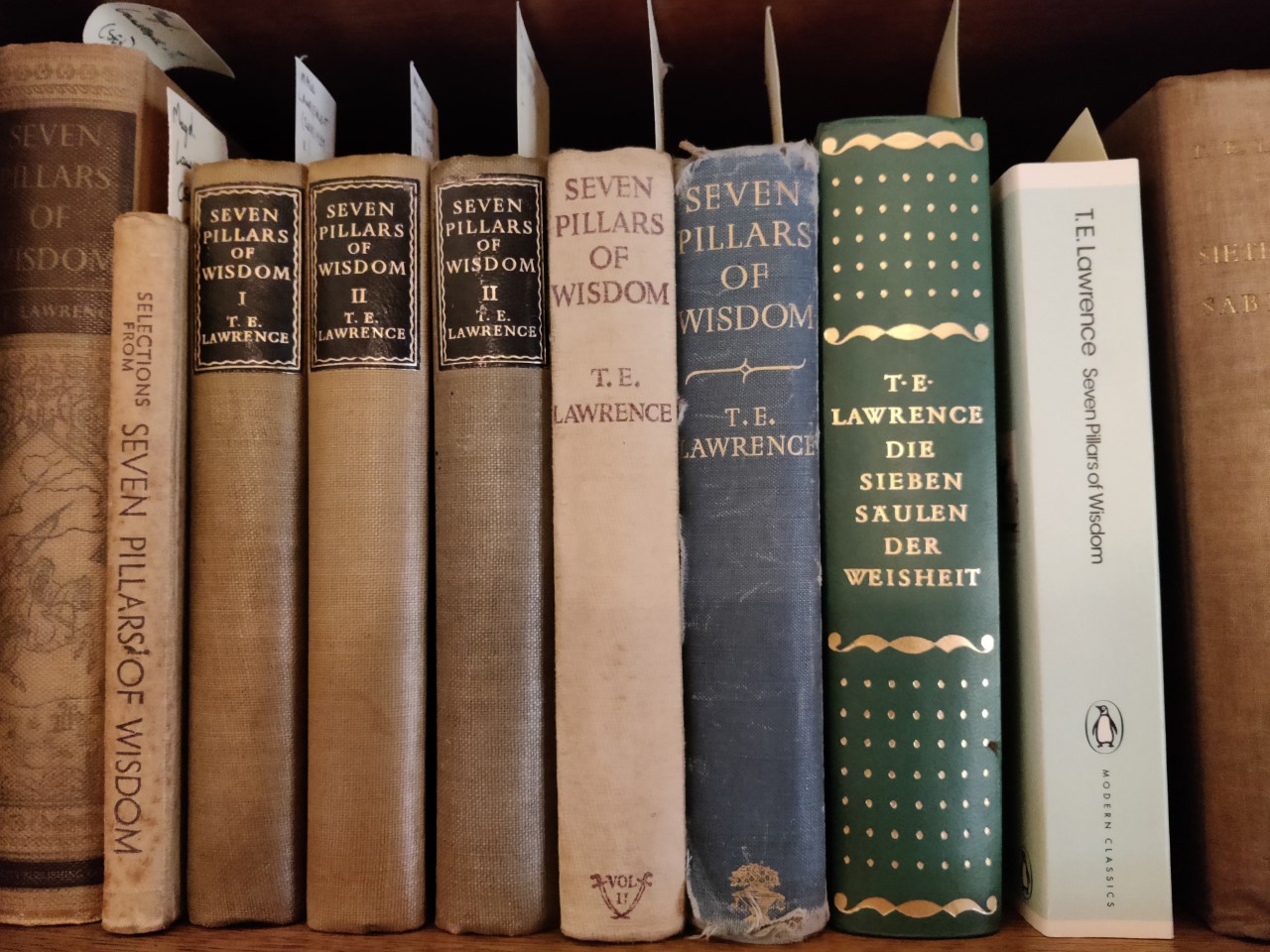

When most people think of Lawrence of Arabia, they naturally picture the Middle East.
Lawrence had always gravitated towards this region. After working at Carchemish, he wrote ‘I don’t think anyone who has tasted the East as I have would give it up half-way, for a seat at high table and a chair in the Bodleian’. On this page, we explore his experiences in the Middle East in more detail, first at Carchemish and later during the First World War. The part he played in this global conflict would lead to Lowell Thomas, an American journalist, turning him into a household name.

[Photograph of C. Leonard Woolley and T.E. Lawrence, 1912. Photographer unknown, first published in C.L. Woolley, Dead Towns and Living Men, London: Oxford University Press, 1920. Magdalen College Library, Magd.Lawrence-T. WOO]
In 1911, Lawrence joined the British Museum excavation at Carchemish, with its camp set up at the nearby village of Jarabulus. Thanks to the financial support offered by Magdalen, Lawrence would spend four seasons at Carchemish, first under the supervision of R.C. Thompson, and then later under C. Leonard Woolley. “The notion of a crusade,” wrote E. M. Forster, “[…] now possessed him, and I think it never left him, though the locality of the other country varied.” On site he perfected his Arabic and French, learned how to lead the large teams of people who worked on the site, regularly tested his intellectual and physical mettle, and displayed a keen mind for identification and classification of archaeological finds. The seasons for excavation at Carchemish were spring and autumn; between the spates of intense work Lawrence travelled east to Mesopotamia and south to Palestine and Egypt, including a brief season working under the distinguished archaeologist Flinders Petrie in Faiyum in the early months of 1912. Below, you can see an image of the Carchemish dig team. Click on the dots to discover more:

Lawrence is pictured in the centre of the image, seated next to C. Leonard Woolley, director of excavations.
The excavations uncovered substantial remains of the Assyrian and Neo-Hittite periods. Lawrence excavated a house in the Inner Town, where he discovered many hieroglyphic inscriptions.
The majority of the workforce on the dig was local. Such an arrangement was common at British Museum digs in this period.
Dahoum
Lawrence's young protégé Dahoum sits on the right of the front row. Lawrence encouraged his education and taught him how to make 'squeezes' (casts) of the inscriptions discovered at Carchemish. He is believed by many to be the "S.A." to whom Seven Pillars of Wisdom is dedicated, although opinions continue to differ.
© The Trustees of the British Museum. Shared under a Creative Commons Attribution-NonCommercial-ShareAlike 4.0 International (CC BY-NC-SA 4.0) licence.
An insight into Lawrence’s life at Carchemish can be gleaned from a letter in Magdalen College Archives. In 1913, T.E.’s closest brother in age, Will, finished his degree at St John’s and immediately set out for St Stephen’s College, Delhi, where he taught English and History until 1915. On his way out, Will stopped off in Syria to visit his brother at Carchemish and wrote to their mutual friend Leonard Green in December of 1913. His letter conveys both the romance and elitism that British visitors to the region experienced:
“… Do try to get out to Ned someday. Let me try to show you a few of the things I’ve done. First of all imagine a great tent full of hundreds of people … & open to the winds & the stars. The skirl of pipes & the beating of a drum. And me sitting there cross-legged on cushions & being fed by Busrawi Agha, Chief of the Milli Kurds & the great murderer of Adana … And afterwards I had a great ride over the moon-lit step with a score & more Arab & Kurds, all night skipping along on the best horses of Mesopotamia, till the sun rose & we galloped.”
In February 1913, Lawrence returned to Carchemish for what would be his fifth season (third year) on the dig. Hamoudi, the site foreman, or Dahoum, Lawrence’s local confidant, let him know that an ancient cemetery had been uncovered nearby at Deve Hüyük and that it was being heavily looted. Lawrence scouted the site under cover, discovering that the cemetery was Hittite and used subsequently over a long period of time. He reported his findings to Woolley on his return to Syria for the start the season. Hamoudi was quickly sent to take control of Deve Hüyük and the British Museum team deployed some of its own more formally legitimate labour to excavate the entirety of the site and ship the contents en masse back to England. By April, twenty crates of artefacts had reached D. G. Hogarth in London, and pieces were distributed to various museums including the Ashmolean Museum, the British Museum, and the Fitzwilliam Museum.

Three bronze bowls, Northern Syria (Neo-Hittite), 9th century B.C.E. Magdalen College, Chattels CO813
The three bowls (pictured above) are all cast bronze from the Neo-Hittite period. They are lesser duplicates of those sent to London which Lawrence kept and gave to Barker, his old history tutor at St John’s. In 2017, his descendant Nicolas Barker Esq. donated them to Magdalen College.

Photograph of C. Leonard Woolley and T.E. Lawrence, 1912 (pictured opposite). Photographer unknown, first published in C. L. Woolley, Dead Towns and Living Men, London: Oxford University Press, 1920. Magdalen College Library, Magd.Lawrence-T. WOO.
In Carchemish, Lawrence found happiness, purpose, and an individual drive that he would strive to recover for the rest of his life. To the right (click to enlarge), you can see one of the few images that survives of C. Leonard Woolley and Lawrence working together in Carchemish. In the photograph, Woolley is wearing his New College Blazer and Lawrence is wearing a Magdalen College Boat Club blazer with a Kurdish sash. Despite working hundreds of miles from Oxford, the two men clearly kept up university traditions on the dig site.
Woolley remembered Lawrence’s developing skills fondly, but he also frustrated the seasoned archaeologist. When asked to produce a lengthy description of a relief, Lawrence would only scribble down a few sentences and then take a series of photographs. “His impatience for the written record might have been due in part to his prodigious memory … he would look at a small fragment of a Hittite inscription … and remark that it fitted on to an equally small piece found twelve months before.”

C. L. Woolley and T. E. Lawrence, Carchemish: a report on the excavations at Djerabis. London: British Museum, 1914-1952 (3 vols.) Magdalen College Library, Magd.Lawrence-T. BRI.
Lawrence’s work at Carchemish culminated in 1914. At the end of the dig, he contributed photography, drawings, and descriptions to the official reports of the British Museum, his first published work. Above, you can see a set of the three British Museum published reports on the excavations. The reports come from the libraries of two of Lawrence’s biographers: Robert Graves and Jeremy Wilson. The year 1914, though, is remembered for very different reasons. As conflict spread across Europe and further afield, Lawrence was not immune from far reaching effects. Like every member of his generation, his life would be completely changed by the outbreak of the First World War.

While an undergraduate at Oxford, Lawrence had explored histories of military theory until he was “tolerably read,” as he later put it. He studied Maurice de Saxe’s 1749 Reveries on the Art of War and Stevenson’s history Crusaders in the East, as well as the strategic thinking of the Prussian generals Carl von Clausewitz, Rudolf von Caemmerer, and Helmuth von Moltke. These ideas would become crucial when the First World War broke out.
In the first months of the war, Lawrence was posted to the Intelligence Department in Cairo, under Captain Gilbert Clayton, gathering information on Ottoman military positions in the region and drawing up strategies for an Arab revolt in alliance with the British. In one letter from the College Archives, you can gain a fascinating glimpse into his thoughts at the start of the conflict.

Two-page letter on “Military Intelligence Office, War Office, Cairo” letterhead, 1915. Magdalen College Archives, MC: P272/C1
In this letter (pictured right, click to enlarge), Lawrence writes back to his mentor, D.G. Hogarth, describing the scene in Cairo, where strategies are drawn up and delayed repeatedly. For a man who had read so much military theory, he is frank about his lack of practical experience: “It’s very dull: but of course I haven’t had any training as a field officer, and I don’t know that I want to go fighting up to Constantinople. It would be bad form, I think”. He and others in the Intelligence Department had pushed the British to capture Alexandretta, now Iskenderun on the southern Turkish coast. But the British government rejected the idea, and instead troops landed fatefully on the Gallipoli Peninsula a few days after this letter was written.
By 1916, Lawrence was part of a newly-established Arab Bureau, run from Cairo, which became the focal point of British war-time intelligence on the region. Soon he was out in the desert, helping regional leaders to shape an Arab Revolt against the Ottomans – a revolt which ultimately would serve British designs for the region.
Lawrence quickly decided it was likely to be more effective not to try to capture major towns in full battle confrontations, but to sabotage Ottoman supply lines in an insurgent campaign. ‘Suppose we were (as we might be) an influence, an idea, a thing intangible, invulnerable, without front or back, drifting about like a gas?’ he wrote in Seven Pillars. ‘Armies were like plants, immobile, firm-rooted, nourished through long stems to the head. We might be a vapour, blowing where we listed.’ From this guerrilla warfare grew the success of the Arab Revolt of which Lawrence was a crucial part along with Feisal, son of Sharif Hussein of Mecca.
Lawrence drew maps charting the progress of his irregular military campaign with the Arab forces. In spring 1917, Lawrence and a force of Arab fighters under Auda Abu Tayi, of the Howeitat tribe, rode on Aqaba. This campaign became one of the most famous expeditions of the entire war. Lawrence had not secured the formal approval of the British military, who were reluctant to let Aqaba come under Arab control. “I decided to go my own way, with or without orders”, he wrote in Seven Pillars. Lawrence and Abu Tayi travelled from Wejh, on the Red Sea coast of what is today Saudi Arabia, northeast to Maan, and then through hundreds of miles of desert to reach Aqaba by land from the east.
Lawrence drew the fragile sketch map (pictured above right, click to enlarge) on a sheet of greaseproof paper, marking their route. The map shows El Houl, a barren plain near the Hejaz railway about which Lawrence wrote: “We, ourselves, felt tiny in it, and our urgent progress across its immensity was a stillness or immobility of futile effort.” On 6 July 1917, the Arab forces captured Aqaba.
Once Lawrence was engaged in the war, he joined the ranks of those who harboured ambitions to remake the map of the Middle East, and in his case to build a new Arab nation. He believed that such a position was official British policy. In 1915-16 the British High Commissioner in Egypt, Sir Henry McMahon, had promised Sharif Hussein that an independent Arab kingdom would be granted. Despite this assurance, the British were working with the French at the same time to hinder the creation of an independent Arab state. Sir Mark Sykes, a British Middle East advisor, and Charles François Georges-Picot, the former French consul general in Beirut, had already divided the region up for their respective governments in 1916. In the map below, you can see their demarcation, known as the Sykes-Picot Agreement:
This map symbolises the ambition, and arrogance, of the Western colonial project in the Middle East. In the blue zone, covering southern Anatolia and the Syrian coast, the French would run their own ‘direct or indirect administration’; in the red zone, including Baghdad and Basra, the British would run theirs. In Zone A, covering Mosul, Aleppo and Damascus, the French would have informal control; in Zone B, stretching from Amman to Kirkuk, the British would have informal control. Palestine was to be internationally administered. The land Sharif Hussein was promised for his independent kingdom had already been allotted to the British and the French.
The Sykes-Picot Agreement left Lawrence, in his own words, “continually and bitterly ashamed”. In the final weeks of the war, he was still trying to convince the cabinet to grant an independent Arab kingdom that would be sympathetic to British interests. In a memo in 1916, Lawrence wrote: “The Arabs are even less stable than the Turks. If properly handled they would remain in a state of political mosaic, a tissue of small jealous principalities, incapable of cohesion, and yet always ready to combine against an outside force.” The map pictured on the right (click to enlarge) represented his vision of a future Middle East, with Feisal, the son of Sharif Hussein of Mecca, granted a large independent kingdom including Damascus. The British would have significant influence over southern Iraq; the French a much-reduced influence, focused on the coast around Beirut. The plan was presented to the Eastern Committee of the cabinet in November 1918, but was never acted on.

After the First World War, Lawrence solidified his support for an Arab state – in typically egocentric terms – in his seminal work Seven Pillars of Wisdom. In it, he wrote “I meant to make a new nation, to restore a lost influence, to give twenty millions of Semites the foundations on which to build an inspired dream-palace of their national thoughts.”
Throughout the book, Lawrence recounts his experiences in the Middle East during the First World War, from the first Arab rebellion against the Ottomans in 1916 to the capture of Damascus in October 1918. “It is intended to rationalize the campaign, that everyone may see how natural the success was and how inevitable, how little dependent on direction or brain, how much less on the outside assistance of the few British,” Lawrence wrote. “It was an Arab war waged and led by Arabs for an Arab aim in Arabia.”
The biography of Seven Pillars is as mythologised as the life of its author. Lawrence wrote the first manuscript in the opening months of 1919 in Paris, during the Peace Conference. The entire text was lost or stolen “at Reading Station, while changing trains” in late 1919. He wrote a second manuscript from memory, because he had already destroyed most of his war-time notes. It took him less than three months and was, he said, “hopelessly bad as a text”. He burnt all but one page in 1922.
He wrote the third text in 1921-22, between Jeddah, Amman, and London. This version was shorter and “composed with great care”. Oxford again played a pivotal role in his life in this period. Arthur Cowley, a Bodleian librarian and former Magdalen fellow, met with Lawrence to receive the final manuscript for the library (pictured right, click to enlarge). Lawrence later commented on this meeting, writing “In giving my MS to the Bodleian I acted perhaps unhumorously taking myself a little too seriously as a classic. Cowley was equal to the occasion, & never smiled at all throughout the transaction. Whether he has a treasure or not the next century can tell. It rids me of a bulky weighty volume. A neat manuscript don’t you think?”. Below, you can see a page of this manuscript edition:
This page of the book introduces Sharif Hussein ibn Ali of Mecca, the Hashemite leader who declared a rebellion against the Ottoman Empire in 1916. His sons, notably Feisal, would go on to lead the Arab Revolt with Lawrence against the Ottomans.
Lawrence revised Seven Pillars of Wisdom still further for a 1926 Subscribers’ Edition, of which only a limited number of copies were available for purchase. Although he had convinced subscribers to pay handsomely for the 1926 edition of Seven Pillars, it was not a financial success. The illustrations, printing, and binding had cost him far more than he made back from the subscriptions. Overdrawn at the bank, Lawrence quickly produced an abridged version, Revolt in the Desert, parts of which were serialised in the Daily Telegraph before the book was published by Jonathan Cape in 1927. It soon became a bestseller, paying off Lawrence’s overdraft within a few weeks. But he did not profit personally from the sales; he had made the copyright over to a charitable trust. The next edition of Seven Pillars was published by Jonathan Cape only after Lawrence died in a motorcycle accident in May 1935. Fifty thousand advance copies of this edition were sold. Since then, the book has been reprinted and translated in editions published across the world.
Thanks to his exploits in the Middle East in the First World War, Lawrence gained fame throughout Britain and the wider world. The publication of his Seven Pillars of Wisdom and its popularity only added to this fame over time. Yet Lawrence struggled both with his celebrity status and his enduring legacy, continuing to feel guilty over the British treatment of the Arabs after the conflict’s end. On the next and final tab of our exhibition, we will focus on his fame, both the fame that he encountered during his life and his continuing influence after his death – both at Magdalen and further afield.